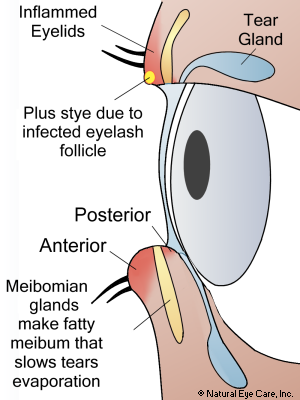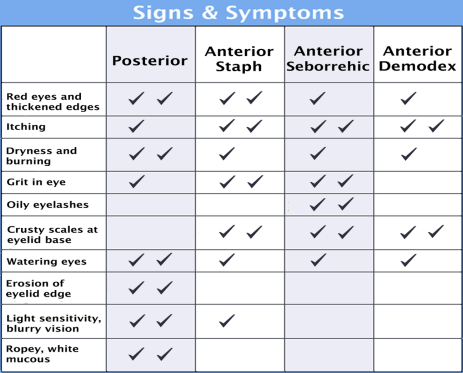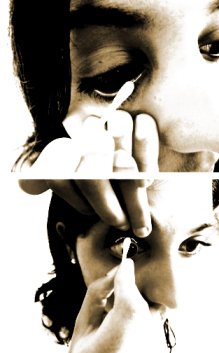Blepharitis (eyelid inflammation)
Vitamins/supplements Types Symptoms & Causes Self help discussion Massage protocol News
Blepharitis is identified as inflamed eyelids which may arise from a number of causes such as irritations and allergies, infections, and insect bites. It can range from a mild, chronic condition due to allergies, or to a severe form with ulcerated eyelids and even damage to the eyes or eyelids.
 Learn about treatment for eyelid health.
Learn about treatment for eyelid health.

Behind the eyelids and eyelashes are several glands. The Meibomian glands secrete a fatty substance called meibum that spreads (via blinking) over the surface of the eye and slows the evaporation of tears. Tear-secreting glands also lie behind the eyelids.
Blepharitis is identified by the presence of "greasy scales" between the eyelashes and by redness on the lid around the eyelashes caused by the body’s immune response (increased blood flow). Sometimes tiny veins expand and are noticeable (telangiectasia); the eyelid can become swollen.
Dysfunctioning of the meibomian gland may cause or contribute to blepharitis in the front or back of the eyelid. Blepharitis may occur as acute (often sudden onset) or chronic (ongoing).
Anterior blepharitis is found on the front and outside of the eyelid along the line of eyelashes. Inflammation there is most commonly caused by bacteria such as (Staphylococcus) and scalp dandruff (seborrheic dermatitis). Increased meibomian gland activity may also occur.2
Posterior blepharitis is found on the the inner moist part of the eyelid that touches the eyeball. It is caused by dysfunctioning meibomian glands. Among other causes there are two skin disorders can cause posterior blepharitis: scalp dandruff and acne rosacea leading to red and inflamed skin.3
Symptoms
Symptoms are redness, itching, scaling, swelling crusting of the eyelashes. It may be accompanied by styes and chalazia. Posterior blepharitis causes dry eyes. Tiny veins may be swollen enough to be visible.
Blepharitis is also linked to acne rosacea.

Causes
Bacteria, dandruff, and fungi are commonly thought to be causes of blepharitis. But what may be more important is that the presence of these toxins that change the healthy environment of the eyelid and produce pro-inflammatory cytokines, toxins, and free radicals.4
Anterior Blepharitis
Bacteria may cause this type of blepharitis, including several types of staphylococcus and propionibacterium acne.
Scalp dandruff (seborrheic dermatitis) or a mix of bacteria and dandruff is also very common. This form of blepharitis allows increased growth of malassezia yeasts that live in the sebum oil of the skin. This type of blepharitis is not as severe as a staph infection, but the eyelids will look greasy and scaly. The patient may also have dandruff, acne, or eczema.
Fungi have also been found to be present with blepharitis and may be a cause. These include penicillium, candida, and trichophyton.5 Researchers have also identified pityrosporum yeasts.6
Demodex mites have also been found in blepharitis eyelids.7 The presence of mites or microbes on the eyelids does not prove that they caused the condition. Rather all that can be said is that, they found the changed eyelid habitat more hospitable than that of a healthy eyelid. In fact, in such cases, treatment with antibiotics or steroids may change the microbial life of the healthy eyelid in favor of specific antibiotic-resistant strains.
Irritation from insect bites, scratches, or infections.
Allergies from pollen or environmental pollutants.
Posterior Blepharitis
Meibomian gland dysfunction is the most common cause of posterior blepharitis; although it may also contribute to anterior blepharitis.
Skin conditions such as rosacea and scalp dandruff can also cause posterior blepharitis.
Conventional Treatment
Conventional treatment depends on the specific type and severity of blepharitis. Mild symptoms may only require warm soaking and daily lid hygiene. Diluted baby shampoo may be used for cleansing of the lids. Other varieties may require antibiotics and/or cortisone cream, or even oral antibiotics, any of which should only be used under medical supervision.
Self Help & Tips
- Avoid rubbing your eyes.
- Apply a warm, wet washcloth as a compress to the affected area and hold it in place until cool. Repeat this 3 to 4 times a day.
- Use a commercial lid "scrub" or baby shampoo on a cotton swab to wash your lids. We provide sterile, preservative- and fragrance-free LidHygenix is a gentle foam solution to cleanse the eyelid.
- Castor oil. (fresh and from the health food store) - place a small bit on a q-tip and apply to the inner lower lid margin.
- Honey. same application as with castor oil. Thin with sterile spring water to reduce stinging. This can be done while doing the "Sunning" eye exercise (see free eye exercises) because it really brings on tearing. Honey is antibiotic, anti-fungal, and antiviral.
- Salt and baking soda. 1/4 teaspoon of salt + 1/4 teaspoon baking soda in 1/2 cup of warm water which has been boiled. Dip finger in the mixture and rub on eye lid margins with eyes closed. Once in the morning and once at night before bed.
- Massage protocol. One study reports beneficial results with a specific massage protocol for blepharitis1, as follows:
 During a comfortable warm shower close the affected eyelid(s) and using the thumb(s) and index finger(s), gently massage the upper lid downward with your index finger(s) and
the lower lid upward with your thumb(s) for 30 seconds.
During a comfortable warm shower close the affected eyelid(s) and using the thumb(s) and index finger(s), gently massage the upper lid downward with your index finger(s) and
the lower lid upward with your thumb(s) for 30 seconds.
After shower use a warm water-moistened Q-tip to gently but firmly scrub all eyelid edges from where the lashes grow (not the red inside of the eyelid), being careful to not touch the sensitive cornea.
Lower lid: Hold the Q-tip in your hand, close enough to the tip for stability, perhaps an inch or two from the end. Use the index finger of the other hand to gently pull down the skin below your eye, to turn out the eyelid, so that it is further from the sensitive cornea. Scrub in small sections (1/5 of the eyelid length) for 3 seconds each across the edge.
Upper lid: This time hold and turn out the upper eyelid by reaching your hand over your head from above - so that again, the eyelid is turned away from the sensitive surface of the cornea. Using two finger to pull up the eyelid may work best.
Blepharitis News
Want to learn more? See our blog news on blepharitis.
 See Vitamins & Supplements to support eye health.
See Vitamins & Supplements to support eye health.
Research & Information
Although the underlying physiological cause may be unique, there may be similarities in terms of nutritional, diet and lifestyle recommendations made by Dr. Grossman for eye conditions that result in similar vision symptoms to those of blepharitis.
Footnotes:
1. S.T. Yun, C.W. et al, Utilisation of a Novel Test to Measure Severity and Treatment Efficacy of Posterior Blepharitis, Journal of Ophthalmology, August, 2015.
2. National Eye Institute. Facts About Blepharitis. Retrieved Feb 10 2018 from https://nei.nih.gov/health/blepharitis/blepharitis.
3. Ibid. National Eye Institute. Facts About Blepharitis.
4. Dadaci, Z., Kilinc, F., Ozer, T.T., Sahin, G.O., Acir, N.O., et al. (2015). Periodic acid-Schiff staining demonstrates fungi in chronic anterior blepharitis. Eye (Lond), Dec;29(12):1522-7.
5. Ibid. Dadaci. (2015).
6. Nelson, M.E., Midgley, G., Blatchford, N.R. (1990)). Ketoconazole in the treatment of blepharitis. Eye (Lond), 4(Pl1:151-9.
7. Ibid. Dadaci, (2015).
Vitamins/supplements Symptoms Causes Self help discussion Massage protocol News
 info@naturaleyecare.com
info@naturaleyecare.com



 Home
Home


 Vision
Vision Vision
Vision



 Health
Health Health
Health Research/Services
Research/Services Pets
Pets About/Contact
About/Contact


